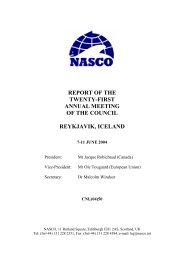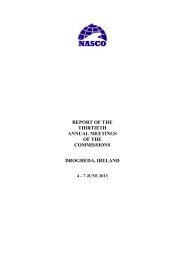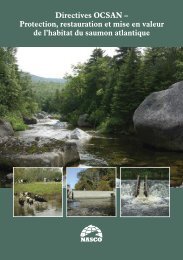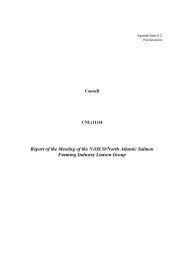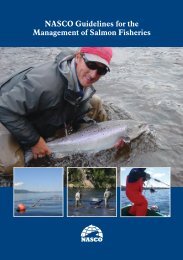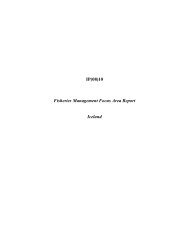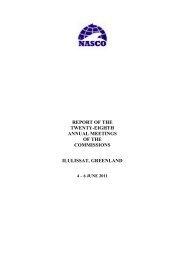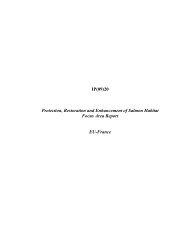Report of the 2005 ICES/NASCO Symposium on Interactions ...
Report of the 2005 ICES/NASCO Symposium on Interactions ...
Report of the 2005 ICES/NASCO Symposium on Interactions ...
You also want an ePaper? Increase the reach of your titles
YUMPU automatically turns print PDFs into web optimized ePapers that Google loves.
NINA SPECIAL REPORT 34<br />
encouraging. But Per Gunnar Kvenseth is quite<br />
c<strong>on</strong>vincing and it would certainly be an ideal<br />
soluti<strong>on</strong>.<br />
The Way Forward - General Principles<br />
I think we’ve come a l<strong>on</strong>g way since Bath and both our<br />
understanding <str<strong>on</strong>g>of</str<strong>on</strong>g> <str<strong>on</strong>g>the</str<strong>on</strong>g> interacti<strong>on</strong>s and our management <str<strong>on</strong>g>of</str<strong>on</strong>g><br />
<str<strong>on</strong>g>the</str<strong>on</strong>g>m have improved significantly. But we have a lot more<br />
work to do toge<str<strong>on</strong>g>the</str<strong>on</strong>g>r and we need to fur<str<strong>on</strong>g>the</str<strong>on</strong>g>r encourage<br />
cooperati<strong>on</strong> between scientists, <str<strong>on</strong>g>the</str<strong>on</strong>g> farming industry,<br />
governments and <str<strong>on</strong>g>the</str<strong>on</strong>g> wild sector. We must regularly<br />
remind ourselves that <str<strong>on</strong>g>the</str<strong>on</strong>g>re is a lot more that joins us<br />
than separates us - we are, in <str<strong>on</strong>g>the</str<strong>on</strong>g> end, all working with<br />
<str<strong>on</strong>g>the</str<strong>on</strong>g> same species. Being aware <str<strong>on</strong>g>of</str<strong>on</strong>g> this will inspire us to<br />
c<strong>on</strong>stantly seek win-win soluti<strong>on</strong>s.<br />
6. Øyvind Walsø<br />
First <str<strong>on</strong>g>of</str<strong>on</strong>g> all I would like to support what has already been<br />
said during this symposium that in recent years we have<br />
seen positive developments with regard to some <str<strong>on</strong>g>of</str<strong>on</strong>g> <str<strong>on</strong>g>the</str<strong>on</strong>g><br />
factors in aquaculture that cause negative impacts <strong>on</strong> wild<br />
salm<strong>on</strong> stocks. We have also taken a huge step forward<br />
in developing a comm<strong>on</strong> understanding <str<strong>on</strong>g>of</str<strong>on</strong>g> <str<strong>on</strong>g>the</str<strong>on</strong>g> implicati<strong>on</strong>s<br />
<str<strong>on</strong>g>of</str<strong>on</strong>g> escapes <str<strong>on</strong>g>of</str<strong>on</strong>g> farmed fish for <str<strong>on</strong>g>the</str<strong>on</strong>g> wild salm<strong>on</strong> stocks and<br />
in recognising that it is necessary for <str<strong>on</strong>g>the</str<strong>on</strong>g> industry to<br />
increase its efforts to prevent escapees. At <str<strong>on</strong>g>the</str<strong>on</strong>g> same time<br />
it is clear that <str<strong>on</strong>g>the</str<strong>on</strong>g>re is still some way to go before we can<br />
say that all <str<strong>on</strong>g>the</str<strong>on</strong>g> issues we have been discussing for more<br />
than 15 years now can be said to have been addressed.<br />
The c<strong>on</strong>tinuing escape <str<strong>on</strong>g>of</str<strong>on</strong>g> farmed salm<strong>on</strong> is regarded as<br />
<str<strong>on</strong>g>the</str<strong>on</strong>g> most serious problem when we c<strong>on</strong>sider <str<strong>on</strong>g>the</str<strong>on</strong>g> negative<br />
impacts from aquaculture <strong>on</strong> <str<strong>on</strong>g>the</str<strong>on</strong>g> wild stocks <str<strong>on</strong>g>of</str<strong>on</strong>g> Atlantic<br />
salm<strong>on</strong>. This has been a key topic at <str<strong>on</strong>g>the</str<strong>on</strong>g> previous<br />
meetings, held in Loen, Norway in 1990, and in Bath,<br />
England in 1997. It has also been an important topic at<br />
this symposium. It seems that both <str<strong>on</strong>g>the</str<strong>on</strong>g> fish farming<br />
industry and <str<strong>on</strong>g>the</str<strong>on</strong>g> wild salm<strong>on</strong> interests now share<br />
comm<strong>on</strong> ground when it comes to <str<strong>on</strong>g>the</str<strong>on</strong>g> importance <str<strong>on</strong>g>of</str<strong>on</strong>g><br />
minimising escapees.<br />
In spite <str<strong>on</strong>g>of</str<strong>on</strong>g> <str<strong>on</strong>g>the</str<strong>on</strong>g> effort that has been invested in improving<br />
c<strong>on</strong>tainment in net pens we see that <str<strong>on</strong>g>the</str<strong>on</strong>g> number <str<strong>on</strong>g>of</str<strong>on</strong>g> fish<br />
escaping has been fairly stable in recent years. While <str<strong>on</strong>g>the</str<strong>on</strong>g><br />
proporti<strong>on</strong> <str<strong>on</strong>g>of</str<strong>on</strong>g> farmed fish that escape may be declining,<br />
that improvement has until now been counteracted by<br />
<str<strong>on</strong>g>the</str<strong>on</strong>g> increase in <str<strong>on</strong>g>the</str<strong>on</strong>g> scale <str<strong>on</strong>g>of</str<strong>on</strong>g> <str<strong>on</strong>g>the</str<strong>on</strong>g> producti<strong>on</strong> <str<strong>on</strong>g>of</str<strong>on</strong>g> farmed<br />
salm<strong>on</strong>. As I said, <str<strong>on</strong>g>the</str<strong>on</strong>g> number <str<strong>on</strong>g>of</str<strong>on</strong>g> escapees remains too<br />
high and when it comes to <str<strong>on</strong>g>the</str<strong>on</strong>g>ir impact <strong>on</strong> wild salm<strong>on</strong><br />
populati<strong>on</strong>s it is <str<strong>on</strong>g>the</str<strong>on</strong>g> number <str<strong>on</strong>g>of</str<strong>on</strong>g> escapees that is important.<br />
The numbers remain far too high.<br />
Much has been said about physical c<strong>on</strong>tainment measures<br />
- less about <str<strong>on</strong>g>the</str<strong>on</strong>g> possibilities <str<strong>on</strong>g>of</str<strong>on</strong>g> biological c<strong>on</strong>tainment, for<br />
example through <str<strong>on</strong>g>the</str<strong>on</strong>g> use <str<strong>on</strong>g>of</str<strong>on</strong>g> sterile salm<strong>on</strong>. The possible<br />
use <str<strong>on</strong>g>of</str<strong>on</strong>g> triploid fish was discussed at <str<strong>on</strong>g>the</str<strong>on</strong>g> previous meetings<br />
as well as this week in Bergen. The issue was also<br />
discussed at <str<strong>on</strong>g>the</str<strong>on</strong>g> <str<strong>on</strong>g>NASCO</str<strong>on</strong>g>/North Atlantic salm<strong>on</strong> farming<br />
industry Liais<strong>on</strong> Group Workshop held in Tr<strong>on</strong>dheim in<br />
August this year. I feel that <str<strong>on</strong>g>the</str<strong>on</strong>g> answers c<strong>on</strong>cerning how<br />
well triploid salm<strong>on</strong> can perform in aquaculture are<br />
somewhat c<strong>on</strong>fusing. The answer you get can vary from<br />
triploid salm<strong>on</strong> can perform as well as diploids to <str<strong>on</strong>g>the</str<strong>on</strong>g>ir<br />
performance is so poor that <str<strong>on</strong>g>the</str<strong>on</strong>g> industry will not accept<br />
<str<strong>on</strong>g>the</str<strong>on</strong>g>m. There was also a suggesti<strong>on</strong> that more effort<br />
should be invested in research into alternative methods<br />
for sterilizing fish. To my mind this is a good idea that<br />
deserves fur<str<strong>on</strong>g>the</str<strong>on</strong>g>r c<strong>on</strong>siderati<strong>on</strong> in <str<strong>on</strong>g>the</str<strong>on</strong>g> future.<br />
When it comes to sea-lice, it seems that <str<strong>on</strong>g>the</str<strong>on</strong>g> effort that<br />
has been put into addressing this problem has paid <str<strong>on</strong>g>of</str<strong>on</strong>g>f.<br />
We now know much more about how this problem can<br />
be addressed and how it should be followed up both<br />
regarding future research and <str<strong>on</strong>g>the</str<strong>on</strong>g> management <str<strong>on</strong>g>of</str<strong>on</strong>g> farms.<br />
Yesterday we heard a number <str<strong>on</strong>g>of</str<strong>on</strong>g> excellent presentati<strong>on</strong>s<br />
<strong>on</strong> this topic and from my point <str<strong>on</strong>g>of</str<strong>on</strong>g> view <str<strong>on</strong>g>the</str<strong>on</strong>g> results from<br />
this research were <str<strong>on</strong>g>the</str<strong>on</strong>g> most positive news from this<br />
symposium.<br />
And it also shows that if <str<strong>on</strong>g>the</str<strong>on</strong>g>re is a challenge to be<br />
addressed and if <str<strong>on</strong>g>the</str<strong>on</strong>g> wild fish interests and farming<br />
interests really share comm<strong>on</strong> ground and work toge<str<strong>on</strong>g>the</str<strong>on</strong>g>r<br />
<str<strong>on</strong>g>the</str<strong>on</strong>g> probability for success is high and certainly much<br />
higher than if we were not working toge<str<strong>on</strong>g>the</str<strong>on</strong>g>r.<br />
So that, ladies and gentlemen, ends my pers<strong>on</strong>al summing<br />
up from this symposium. Presumably <str<strong>on</strong>g>the</str<strong>on</strong>g> next meeting, in<br />
seven years’ time, will be as interesting as this meeting has<br />
been. Thank you very much!<br />
69



